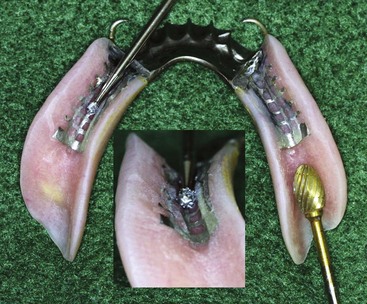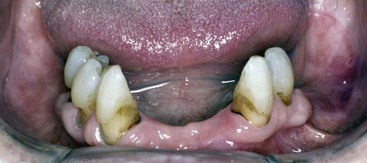CHAPTER 21 Relining and Rebasing the Removable Partial Denture
Differentiation between relining and rebasing the removable partial denture has been discussed previously in Chapter 1. Briefly, relining is the resurfacing of the tissue of a denture base with new material to make it fit the underlying tissue more accurately. Rebasing is the replacement of the entire denture base with new material. The artificial teeth may need to be replaced in a rebase procedure. Relining removable partial dentures is a common occurrence in many dental practices; however, rebasing is not indicated as often.
In either situation, a new impression is necessary and uses the existing denture base with modifications (Figure 21-1) as an impression tray for a closed-mouth or an open-mouth impression procedure. One of several types of impression materials may be used, such as metallic oxide impression paste, rubber-base or silicone elastomers, tissue conditioning materials, or mouth-temperature wax. With a tooth-supported prosthesis, the impression method (open- or closed-mouth) is not as critical. In deciding between a closed-mouth and an open-mouth impression method for relining a distal extension removable partial denture, a major consideration is the resiliency of the mucosa covering the residual ridge. As with secondary impression techniques, a firm mucosal foundation can likely accommodate a closed-mouth functional impression technique or an open-mouth selective pressure technique. However, when the mucosa is easily displaced, the open-mouth selective pressure technique is preferable. Both techniques should guard against framework movement during the impression procedure.
Before relining or rebasing is undertaken, the oral tissue must be returned to an acceptable state of health (Figure 21-2). For more information, refer to the Chapter 13 discussion about conditioning abused and irritated tissue.
Stay updated, free dental videos. Join our Telegram channel

VIDEdental - Online dental courses




